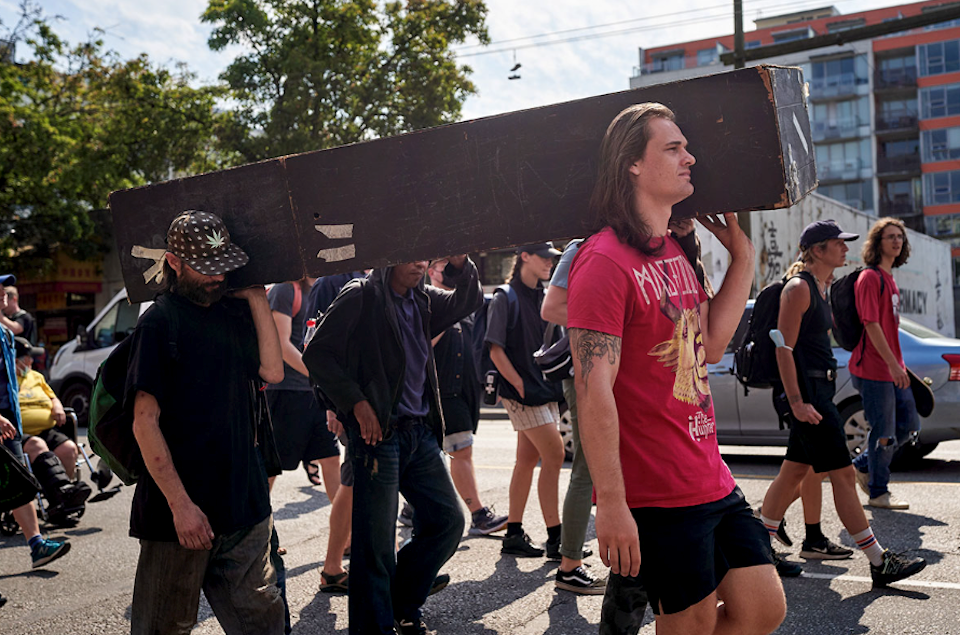A recent legislative committee report on British Columbia’s toxic drug crisis is too timid and misguided to stop record numbers of people from continuing to die, say frontline workers and advocates for people who use drugs.
“The report let us down once again. It gave us hope and then said very little,” said Tyson Singh Kelsall, a social worker in Vancouver’s Downtown Eastside neighbourhood and a doctoral student at Simon Fraser University.
“The urgency I’m seeing on the ground is not in the report.”
A Nov. 1 report from the Select Standing Committee on Health, written by 10 MLAs after four months of consultations, issues 37 recommendations. Those include scaling up prescribed safer supply and harm reduction efforts and building more detox and treatment spaces.
When the report was released, committee chair and NDP MLA for Vancouver-Hastings Niki Sharma said the calls focus on closing gaps in support and reducing barriers to different resources like prescribed safe supply and overdose prevention sites.
“The toxic drug supply knows no borders and is hitting communities around the world. We focused on finding solutions for B.C. to stem the tide,” said Sharma in the legislature last Tuesday.
“It is clear that we need to work collectively to find and focus on solutions that will save lives and help people achieve wellness.”
The report’s stay-the-course recommendations also included more funding to police to refer people they apprehend with drugs to supports. It called to increase the availability of overdose prevention sites and naloxone kits (kits containing injectable agonists to reverse opioid overdoses) across B.C.
In an open letter responding to the Select Standing Committee on Health’s report, 56 individuals and organizations including frontline workers like Singh Kelsall, researchers, drug user rights groups and legal non-profits said the report was a frustrating disappointment.
“This report and its recommendations replicate the same tiresome do-nothing-hope-for-better strategy well-worn by the majority BC NDP government,” reads the letter shared with The Tyee and published by the online publication the Mainlander on Friday.
Since the toxic drug crisis was declared a public health emergency in 2016, more than 10,000 people have died in B.C. This amounts to about six people dying per day, and many more suffering non-fatal drug poisonings that can lead to permanent brain damage and other lasting health impacts.
In that time, the drug supply has become increasingly more potent and unpredictable, contaminated with fentanyl, carfentanil and more recently benzodiazepines and tranquillizers that make opioid overdose more fatal and difficult to reverse.
The letter’s signatories include the BC Civil Liberties Association, Vancouver Area Network of Drug Users and Pivot Legal Society. They call for an accessible, predictable and regulated safe supply of drugs to separate people from the increasingly poisoned and illicit supply.
Nicole Luongo, systems change co-ordinator at the signatory Canadian Drug Policy Coalition, said the report felt like “a bit of a waste of time” and a stark reminder that calls from people who use drugs are not being heeded.
“I don’t think there was much possibility for it to turn out otherwise,” she said.
Signatories also said the report appeared rooted in “old-school addictions medicine” approaches that focus on stopping people from using drugs rather than acknowledging how much deadlier the drug supply has become for anyone who uses, either regularly or infrequently.
“The overdose crisis has long been conflated with other issues like addiction and treatment,” said Singh Kelsall. “But no matter how many people go through treatment or are given better support, the drug supply will remain contaminated and until we address it in a real way, the deaths will continue.”
The report’s findings largely echo previous recommendations from two death review panels convened by the Coroners Service of British Columbia in 2018 and 2022, but without the same concrete timelines to act. The provincial government did not agree to implement the findings of those previous reports.
In response to Tuesday’s findings, Minister of Mental Health and Addictions Sheila Malcolmson said the report “affirmed” the current approach and did not say whether the province would formally adopt the recommendations.
Karen Ward, a Downtown Eastside advocate and City of Vancouver drug policy advisor, got the impression the report was a tool to support staying the course.
“It’s very clear what they recommend is what they could agree to,” said Ward of the majority-NDP MLA committee. “I look at the ‘what we heard’ versus the recommendations and they’re miles apart.”
In Ward’s view, that shows a clear choice by the government to continue on with the current, increasingly deadly trajectory.
“They’re affirming that they’re going to keep killing thousands of people,” she said.
But she doesn’t think the report itself is pointless.
“We need to leverage this report to create a situation where we talk about this as adults in a serious way,” said Ward, “and to recognize this mass poisoning is a result of policy choices and that we can make different ones.”



